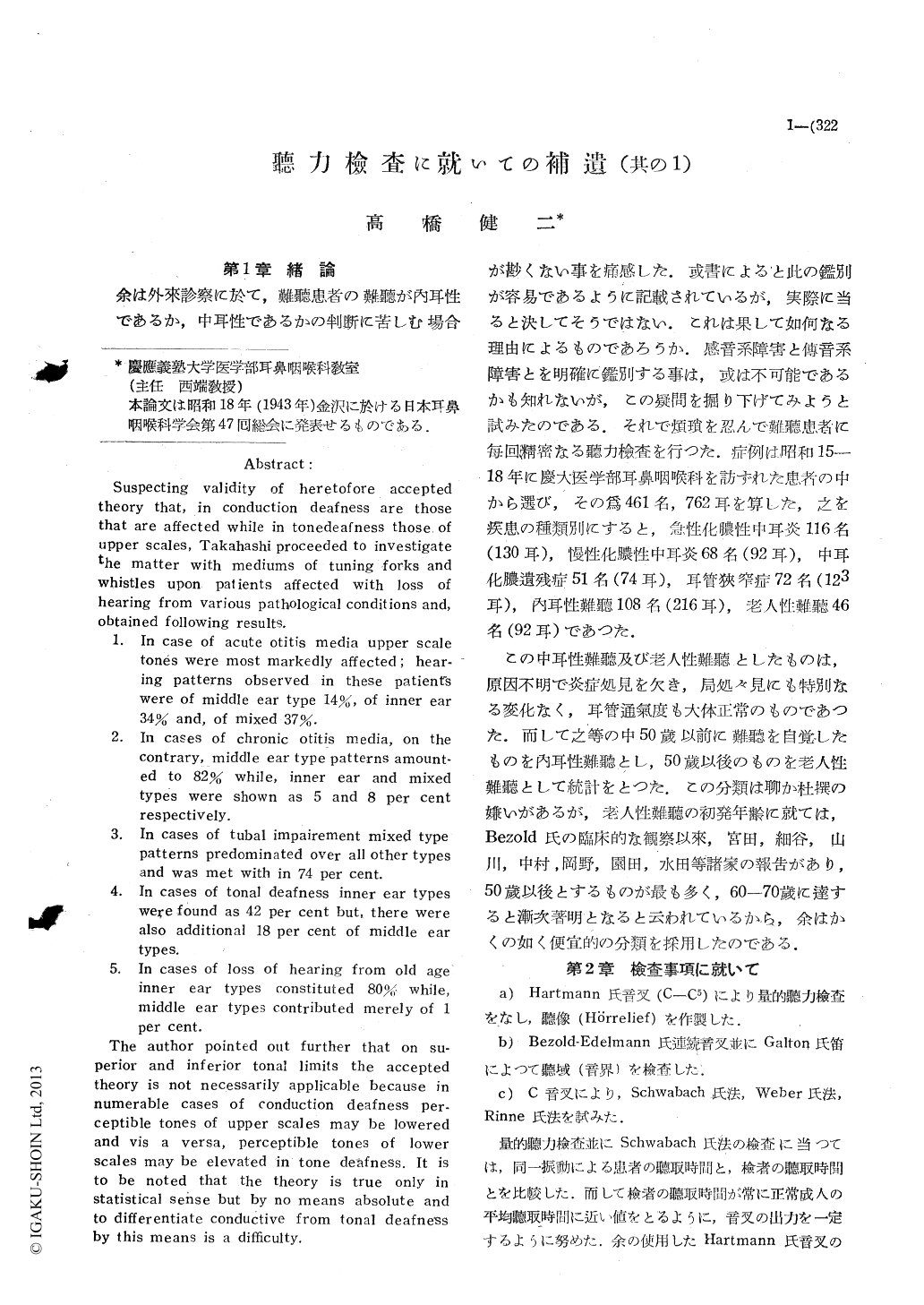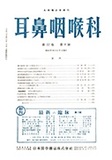- 有料閲覧
- 文献概要
- 1ページ目
第1章
緒論余は外來診察に於て,難聽患者の難聽が内耳性であるか,中耳性であるかの判断に苦しむ場合が尠くない事を痛感した.或書によると此の鑑別が容易であるように記載されているが,実際に当ると決してそうではない.これは果して如何なる理由によるものであろうか.感音系障害と傳音系障害とを明確に鑑別する事は,或は不可能であるかも知れないが,この疑問を掘り下げてみようと試みたのである.それで煩瑣を忍んで難聽患者に毎回精密なる聽力檢査を行つた.症例は昭和15-18年に慶大医学部耳鼻咽喉科を訪ずれた患者の中から選び,その爲461名,762耳を算した,之を疾患の種類別にすると,急性化膿性中耳炎116名(130耳),慢性化膿性中耳炎68名(92耳),中耳化膿遺残症51名(74耳),耳管狹窄症72名(123耳),内耳性難聽108名(216耳),老人性難聽46名(92耳)であつた.
この中耳性難聽及び老人性難聽としたものは,原因不明で炎症処見を欠き,局処々見にも特別なる変化なく,耳管通氣度も大体正常のものであつた.而して之等の中50歳以前に難聽を自覚したものを内耳性難聽とし,50歳以後のものを老人性難聽として統計をとつた.この分類は聊か杜撰の嫌いがあるが,老人性難聽の初発年齢に就ては,Bezold氏の臨床的な観察以來,宮田,細谷,山川,中村,岡野,園田,水田等諸家の報告があり,50歳以後とするものが最も多く,60-70歳に達すると漸次著明となると云われているから,余はかくの如く便宜的の分類を採用したのである.
Suspecting validity of heretofore accepted theory that, in conduction deafness are those that are affected while in tonedeafness those of upper scales, Takahashi proceeded to investigate the matter with mediums of tuning forks and whistles upon patients affected with loss of hearing from various pathological conditions and, obtained following results.
1. In case of acute otitis media upper scale tones were most markedly affected; hearing patterns observed in these patients were of middle ear type 14%, of inner ear 34% and, of mixed 37%.
2. In cases of chronic otitis media, on the contrary, middle ear type patterns amounted to 82% while, inner ear and mixed types were shown as 5 and 8 per cent respectively.
3. In cases of tubal impairement mixed type patterns predominated over all other types and was met with in 74 per cent.
4. In cases of tonal deafness inner ear types were found as 42 per cent but, there were also additional 18 per cent of middle ear types.
5. In cases of loss of hearing from old age inner ear types constituted 80% while, middle ear types contributed merely of 1 per cent.
The author pointed out further that on superior and inferior tonal limits the accepted theory is not necessarily applicable because in numerable cases of conduction deafness perceptible tones of upper scales may be lowered and vis a versa, perceptible tones of lower scales may be elevated in tone deafness. It is to be noted that the theory is true only in statistical sense but by no means absolute and to differentiate conductive from tonal deafness by this means is a difficulty.

Copyright © 1950, Igaku-Shoin Ltd. All rights reserved.


